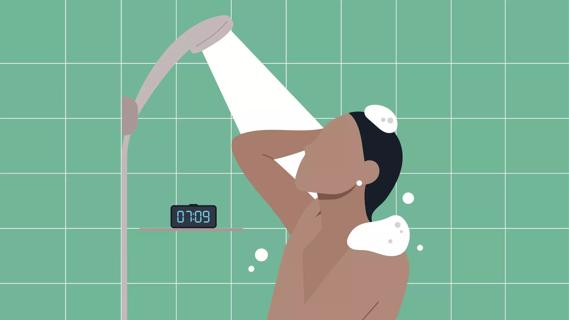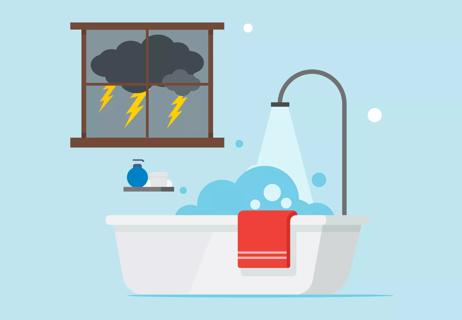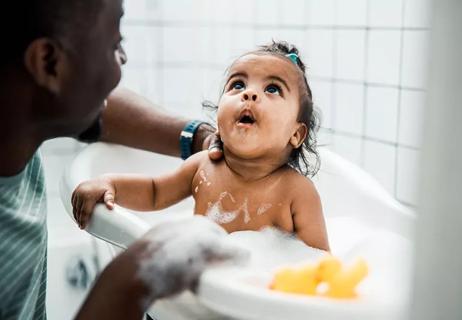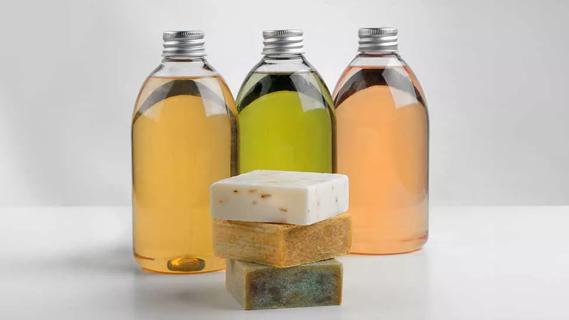Be mindful about temperature, positioning and efficiency when it’s comes to your little one

The nurses made it look so easy at the hospital, didn’t they? They washed, rinsed and dried off your band-new bundle of joy, then diapered and swaddled them up like it was no big deal.
Advertisement
Cleveland Clinic is a non-profit academic medical center. Advertising on our site helps support our mission. We do not endorse non-Cleveland Clinic products or services. Policy
But now it’s your turn. And suddenly, bathing your newborn doesn’t seem as simple as the people at the hospital made it look.
What’s the right bath temperature? Should I start at the top and work down? Or bottom to top? And what to do about that umbilical stump?
Rest assured, you got this.
Pediatrician Peter VanHeyst, DO, walks us through baby’s first bath, so you can be confident your newborn will be safe, sound and oh-so-clean.
A safe newborn bath is all a matter of positioning, temperature and minimizing risk of injury.
Your baby’s first few baths should be sponge baths. As in, using a soapy washcloth to clean them up, rather than putting them in water. Until your baby’s umbilical stump falls off, you don’t want to get their soon-to-be belly button wet if you don’t have to. The stump will come off about two weeks after they’re born. Then you can move on to a full-on bath.
Prepping is key to a quick, easy and safe newborn bath.
“You want to make sure you have all your supplies in arm’s reach,” Dr. VanHeyst says. “That way, you can keep your hands on your baby at all times, which is important to prevent slips.”
Bath time should take place in a temperature-controlled environment. Close any windows to avoid a breeze.
Advertisement
Here’s what you’ll need:
What about lotion?
Dr. VanHeyst recommends waiting on that. “Newborn skin usually isn’t mature enough to deal with lotions. So, we tried to avoid that if we can in the first month. After that, a lotion made for babies should fine.”
Plus, babies are slippery enough as is. No reason to add lotion to the mix and make it even easier for them to slide out of your arms.
Your baby’s bath water should be no more than about 100 degrees Fahrenheit (38 degrees Celsius). That’s because babies are more sensitive to changes in temperature than older kids and adults. They can more easily get uncomfortably hot or cold.
“Babies and adults have a lot different physiological properties when it comes to temperature regulation,” Dr. VanHeyst explains. “You really want the water temperature to be just a little touch warmer than body temperature.”
Think of it like this: An eight-pound turkey will heat up in the oven much more quickly than a 20-pounder. That’s because it doesn’t take as much heat to reach the core of the smaller bird. Babies are the same way. Fluctuations in temperature affect them more because they don’t need as much heat (or cold) to reach their core.
That’s why the American Academy of Pediatrics (AAP) recommends turning your water heater to its lowest setting, no more than120 F (49 C). That will keep your water from accidentally becoming too hot for baby to handle.
Start by washing your baby from their head and work your way down. Their top half is usually the cleanest area, while the diaper area is the most likely area for ick to accumulate. Leaving the messy parts for last means you’re less likely to transfer the messy stuff to the cleaner parts of your baby.
Starting at the top also helps to maintain better control of the baby.
For babies getting a sponge bath, you really only need to focus on the dirty areas. They may not need a rigorous shampooing. Think of it as more like a targeted spot-clean — particularly after a spit-up incident or following a … ahem … diaper malfunction.
Advertisement
Once they’re clean, remove them from the tub and wrap them in a soft towel to dry off. Get them dressed quickly to warm up.
Caution: Babies are slippery when wet. And if your newborn doesn’t love their cleanup job (and they may not), they might fuss around and be even more prone to sliding. It’s scary to consider, but the AAP says babies can drown in as little as one to two inches of water. So, safe positioning and handling is essential.
Dr. VanHeyst offers this advice to keep baby safe from bath time falls:
Sure, you may like to linger in the tub and soak, but it’s better for baby to get clean and move on with their day.
Advertisement
Efficiency is key to keeping your baby comfortable during their bath. Dr. VanHeyst says to aim to keep your baby’s bath to no more than about five minutes. After that, the water will start to cool off and become uncomfortable for your newborn.
You can help keep your baby warm by keeping them dressed while you gather supplies and prep the tub water. Don’t remove their clothes until it’s go-time.
Babies typically don’t need to be bathed more than two or three times per week. Newborns really aren’t that dirty. It’s not like they’re rolling around in mud puddles or working up a sweat in the gym.
That said, babies should be wiped during diaper changes to keep their private parts clean. And a quick sponge-down can get grime out from any rolls in their skin — like under their chin or behind their knees. But a full bath doesn’t need to be a daily ritual.
“Babies shouldn’t be bathed every day. Bath time can be labor intensive for parents, and it sometimes can cause excessive drying to the baby’s skin,” Dr. VanHeyst cautions.
But when they’re due for a bath, be sure to pay attention to temperature and positioning to keep them safe and comfortable. And when you’re done, don’t forget to take a good whiff of that clean-baby smell. Nothing can compare.
Advertisement
Learn more about our editorial process.
Advertisement

It’s a wash — when you bathe is a personal preference

Lightning can strike indoors, even with plastic plumbing — and that includes in the shower

Soaking in the tub benefits your body and your mind

The potential benefits to your circulation and metabolism may not be worth the discomfort

Helpful guidelines for little ones and teens

Weighing the delight (or havoc) for your skin

This olive oil-based soap is generally mild and safe when diluted

Despite unhealthy side effects, 40% of adult Americans still pee in pools

Type 2 diabetes isn’t inevitable with these dietary changes

Applying a hot or cold compress can help with pain